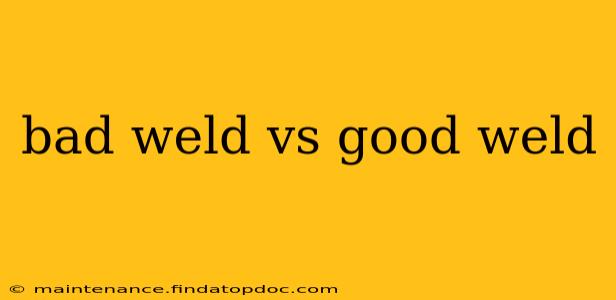Welding is a crucial process in numerous industries, from construction and manufacturing to automotive and aerospace. A strong, reliable weld is paramount for the safety and integrity of any structure or product. However, a poorly executed weld can lead to catastrophic failures. Understanding the differences between a good weld and a bad weld is essential for ensuring quality and safety. This guide will explore the key characteristics to identify each, along with common causes and prevention strategies.
What are the visual differences between a good weld and a bad weld?
A good weld exhibits several key characteristics visible to the naked eye (though more detailed inspection may be necessary). It should possess a smooth, consistent bead with uniform penetration. The weld metal should be free from cracks, porosity (small holes), and other defects. The fusion zone (where the weld metal joins the base metal) should be complete and well-defined, showing a clear transition between the weld and base materials. Color should be uniform, indicating proper fusion and heat input. A bad weld, on the other hand, will show obvious flaws. These could range from incomplete fusion, excessive porosity, cracks (both surface and internal), undercut (where the weld metal doesn't fully fill the joint), and irregular bead shape, suggesting inconsistent welding parameters or improper technique.
What are some common causes of bad welds?
Several factors can contribute to the creation of a bad weld. Improper welding techniques, such as insufficient or excessive heat input, incorrect travel speed, or poor electrode angle, are frequent culprits. The welder's skill and experience play a significant role. Inconsistent current or voltage, inadequate joint preparation, dirty or contaminated base materials, and incorrect shielding gas flow can also lead to weld defects. Finally, using the wrong welding parameters (amperage, voltage, etc.) for a particular material and thickness is a common cause of failure.
How can I tell if a weld is strong enough?
Determining a weld's strength isn't always a simple visual assessment. While visual inspection helps identify obvious defects, more rigorous testing is often necessary to ensure the weld's structural integrity. This may include destructive testing methods like tensile testing (measuring the weld's breaking strength) or bend testing (evaluating its ductility). Non-destructive testing (NDT) methods, such as radiographic testing (X-ray or gamma ray) to detect internal flaws, or ultrasonic testing to measure penetration and identify discontinuities, are also utilized to assess weld quality without damaging the component.
What are the consequences of a bad weld?
The consequences of a bad weld can range from minor inconveniences to catastrophic failures with significant safety and economic implications. A weak weld may lead to premature component failure, requiring costly repairs or replacements. In critical applications, such as bridges, pipelines, or pressure vessels, a faulty weld could result in structural collapse, causing property damage, injuries, or even fatalities. Therefore, ensuring weld quality is paramount.
How can I prevent bad welds?
Preventing bad welds involves a multifaceted approach. Proper training and certification for welders are fundamental. Adequate joint preparation, including cleaning and beveling, is crucial to ensure proper fusion. Maintaining consistent welding parameters, using appropriate filler material, and employing proper shielding gas techniques are equally vital. Regular inspection and quality control procedures, including both visual inspection and NDT techniques, help identify and rectify potential problems before they lead to catastrophic consequences. Employing a robust quality management system throughout the welding process is key to minimizing defects and ensuring high-quality, reliable welds.
What are the different types of weld defects?
Weld defects come in various forms, each with different causes and levels of severity. Some common types include:
- Incomplete Fusion: The weld metal fails to completely fuse with the base metal, resulting in a weakened joint.
- Porosity: The presence of small holes (pores) within the weld metal, reducing its strength and integrity.
- Cracks: Breaks in the weld metal, significantly reducing its strength and making it prone to failure under stress.
- Undercut: A groove formed along the edge of the weld, weakening the joint.
- Overlap: Excessive weld metal extending beyond the joint edges, potentially causing stress concentrations.
- Lack of Penetration: The weld metal does not reach the full depth of the joint, resulting in incomplete fusion.
This comprehensive guide offers a detailed look at the differences between good and bad welds. Remember that safety and quality should always be paramount when working with welds. Regular inspection and adherence to proper procedures are essential for preventing costly errors and ensuring the longevity and safety of welded structures.
